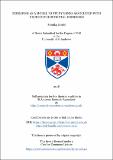Files in this item
Zebrafish as a model to study genes associated with neurodevelopmental disorders
Item metadata
| dc.contributor.advisor | Paracchini, Silvia | |
| dc.contributor.advisor | Sillar, Keith T. (Keith Thomas) | |
| dc.contributor.author | Gostić, Monika | |
| dc.coverage.spatial | 274 p. | en_US |
| dc.date.accessioned | 2018-11-14T10:52:25Z | |
| dc.date.available | 2018-11-14T10:52:25Z | |
| dc.date.issued | 2018-12-06 | |
| dc.identifier.uri | https://hdl.handle.net/10023/16446 | |
| dc.description.abstract | Dyslexia is a neurodevelopmental disorder that affects between 5% and 12% of school-aged children. Individuals with dyslexia have difficulties in learning to read despite normal IQ levels and adequate socio-economical and educational opportunities. Dyslexia has a strong genetic component, but only a few candidate genes have been characterized to date. The KIAA0319 gene is a strong dyslexia candidate found to be associated with dyslexia in independent studies. The KIAA0319 genetic variants associated with dyslexia reside in a regulatory region. Studies in rat suggested that this gene is required for neuronal migration during early cortex formation. The KIAA0319-like (KIAA0319L) is a KIAA0319 homolog in structure and has recently been shown to play a role in dyslexia. I used zebrafish as a model organism both to study the effects of non-coding variants and to characterise kiaa0319 gene function. I used Gateway Tol2 technology to study the role of regulatory sequences. While these experiments led to inconclusive results, they highlighted some of the challenges but also the feasibility of using zebrafish as model organism to study genetic associations. In parallel, I studied the kiaa0319 function with knockout and knockdown experiments. Additionally, I conducted a detailed gene expression analysis with different in situ hybridisation protocols showing kiaa0319 ubiquitous expression in the whole embryo before 12 hours post fertilisation, with later specification to the eyes, brain, otic vesicle and notochord. Additionally, I have tested for the expression of kiaa0319l and showed similar expression pattern to the kiaa0319, but with significantly lower expression of kiaa0319l in zebrafish notochord. My data show, for the first time, that kiaa0319 has stage-specific expression in the brain and notochord during zebrafish early development, suggesting kiaa0319 specific role in the development of these structures. These results are in line with recent mouse studies. With this project I support the idea of kiaa0319 role being extended beyond the brain function and propose a role for kiaa03019 in the visual system and in the notochord. | en_US |
| dc.language.iso | en | en_US |
| dc.publisher | University of St Andrews | |
| dc.rights | Attribution-NonCommercial-NoDerivatives 4.0 International | * |
| dc.rights.uri | http://creativecommons.org/licenses/by-nc-nd/4.0/ | * |
| dc.subject | Zebrafish | en_US |
| dc.subject | Notochord | en_US |
| dc.subject | kiaa0319 | en_US |
| dc.subject | Neurodevelopment | en_US |
| dc.subject | Dyslexia | en_US |
| dc.subject | Tol2 | en_US |
| dc.subject | In situ hybridization | en_US |
| dc.subject | Genetics | en_US |
| dc.subject | kiaa0319l | en_US |
| dc.subject.lcc | QL638.C94G7 | |
| dc.subject.lcsh | Zebra danio--Genetics | en |
| dc.subject.lcsh | Zebra danio--Behavior | en |
| dc.subject.lcsh | Developmental neurobiology--Research | en |
| dc.title | Zebrafish as a model to study genes associated with neurodevelopmental disorders | en_US |
| dc.type | Thesis | en_US |
| dc.type.qualificationlevel | Doctoral | en_US |
| dc.type.qualificationname | PhD Doctor of Philosophy | en_US |
| dc.publisher.institution | The University of St Andrews | en_US |
| dc.identifier.doi | https://doi.org/10.17630/10023-16446 |
The following licence files are associated with this item:
This item appears in the following Collection(s)
Except where otherwise noted within the work, this item's licence for re-use is described as Attribution-NonCommercial-NoDerivatives 4.0 International
Items in the St Andrews Research Repository are protected by copyright, with all rights reserved, unless otherwise indicated.


